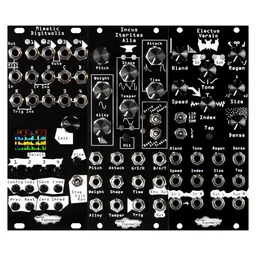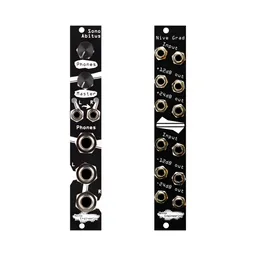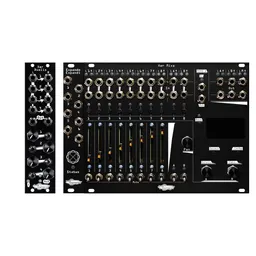Today, we’ll be venturing into the world of utilities again to take a look at the sample and hold (often abbreviated S&H) and learn about some of its common uses. We’ll also explore the lesser known track and hold (T&H) and see what the differences are. These are often considered “advanced” utilities, but they are extremely simple in how they work. While you may not want one as your first module, they are definitely something that you can understand even if you’re just getting started in modular synthesis!
What is a sample and hold?
S&H utilities have three parts: a CV input, a CV output, and a trigger input. Each time it is triggered, it reads the voltage level at the CV input, then outputs that voltage until it receives another trigger.

Sample and hold in a patch
The most famous use of S&H is to generate random voltages: by feeding noise into the CV input, a new random voltage is generated each time the S&H is triggered.

This patch technique is so common that you’ll sometimes see S&H used to describe a random voltage generator. This is misleading, though, as S&H utilities have quite a lot of uses.
One fun example is using them with pitch sequences: it’s easy to create a bassline based on a melody by multing the melody’s pitch CV to a S&H, triggering it with a slow clock (once per measure, for example), then sending the output to a bass voice.
I use S&H modules whenever I’m modulating multiple elements of a patch that happen more slowly than my original modulation signal. For example, I have four percussion voices that I use in my patches, and they are all modulated in some way by a single CV sequencer (either changing their volume or timbre to create accents). The CV sequencer advances on a 16th-note clock, which creates stepped timbral changes in longer percussive hits if the CV is patched in directly. By running the sequencer output through a S&H for each voice, the CV signals only change when the voices are triggered, eliminating the undesired CV stepping.
What is track and hold?
Track and hold is a less common (but equally useful, in my opinion) utility that is similar to a S&H. T&H modules have a CV input and output, and a gate input instead of a trigger input. Instead of sampling signals when triggered, T&H utilities pass CV through when their gate input is low, and hold CV at its most recent level while the gate input is high.

I like using T&H to “pause” CV sequences when I hold a gate-generating button down, or to interrupt sequences with randomly-generated gates.
Voltage droop
One interesting quirk about analog S&H circuits is that they tend to droop — if a voltage is held for a long time, it will start to decrease in value, eventually dropping to zero. The time this takes will vary from module to module and isn’t an issue in many patches, but it may be worth exploring digital S&H modules (which won’t have this issue) if you need to precisely hold voltages for more than a few seconds. This isn’t particularly noticeable when using S&H for modulation, but can become obvious when used with pitch signals.
For advanced patchers: S&H and audio
Most S&H modules can be triggered at audio rates, and we can use them to create the effect of sample-rate reduction by clocking them with an oscillator then running audio to the CV input. Turning the oscillator’s frequency down reduces the sample rate, adding some edge and character to your sound. Sample-rate reduction is commonly used in bitcrushing effects, making this a fun example of analog utilities emulating a digital effect!






